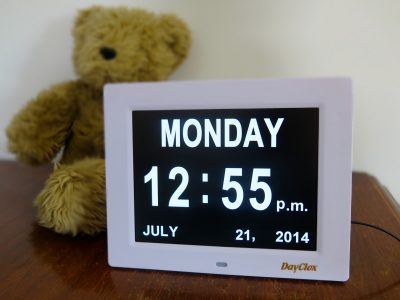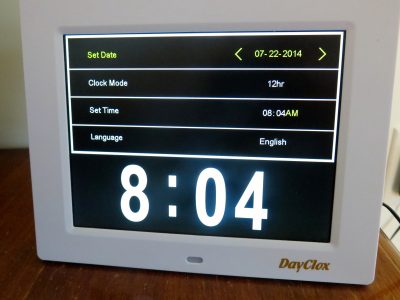
Sometimes it’s the little things in life that make the biggest difference, and for some people this means an easy way to see what time and date it is. Sounds basic, I know, but when advancing age, dementia, stroke, deteriorating eye sight or creeping mental infirmity make ordinary time pieces impossible to use, a just-the-basics clock starts to make sense. I don’t have trouble using regular clocks and watches (not yet, anyway), but timepiece simplicity is still a good thing in my book. Surely I’m not the only one tired of a world filled with over-done, over-featured clocks, am I?
For the last 10 years, my favourite wall clock has been a large, simple, self-setting model with hands. It’s on the wall in my workshop and it’s made by a company called La Crosse. And even though it adjusts its own time based on a wireless signal sent out around the world from Fort Collins, Colorado, it’s still not ideal for people losing the ability to remember time and date information. I’ve seen this happen to a few people, and that’s one reason I took a closer look at something called Dayclox. It may be the world’s easiest-to-read digital clock and calendar.
Dayclox is a plug-in digital clock with an 8” screen that delivers just the basics, nice and clear. Nothing fancy, just day-of-week, time, month and date information are obvious to see and understand. I’ve been using Dayclox in my home for years, and I find it a breath of fresh air. Super-bright, white letters on a black screen make it exceptionally easy to read in my performance tests. My 10 year-old daughter, Ellie, loves to have the clock close to her school desk in the office space above my workshop.
The clock’s display can be set for 12- or 24-hour mode and the calendar has 8 language options. There’s an instruction manual, but I found it unnecessary. Just hit the menu button, then choose different setting options.
The need for a simple, reliable, easy-to-read timepiece is something that struck Ontario nursing home worker Gary Ball, too. And he saw it most obviously because of his mom.
“When my mother moved into the retirement home where I work, she’d wander over to see me more than once a day to ask ‘What day is it?”explained Gary. “I wondered if there might be something out there to help her feel more at ease. I found and bought a Dayclox online for Mom because it looked like it would give her peace of mind. It certainly has. She never has to ask me what day it is now.”
One criticism I can offer is that Dayclox needs to be reset twice a year as daylight savings time come and go. It also needs to be reset if there’s a power failure or if you unplug it. There’s a leg on the back of the clock that extends to allow the unit to stand upright on a table or desk, and a hole in the back of the case for hanging the unit on a wall.
Gary liked his mom’s Dayclox experience so much that a few years ago he set up a Canadian retail website as a sideline to his work at the retirement home (www.daycloxcanada.com). That’s turning out to be a story in itself.
“It’s quite a balancing act getting a little business up and running online,” explains Gary. “Most of our earnings have gone back into the business, and there are lots of things to learn.”
Super-simple, easy-to-read time and date information might not seem like much to most of us, but it can make a difference for individuals with challenges, and those people taking care of them. Like I said, sometimes it’s the little things in life that matter the most.














